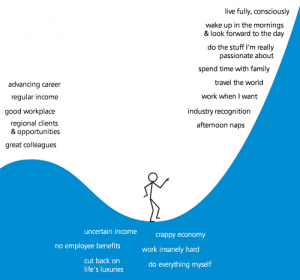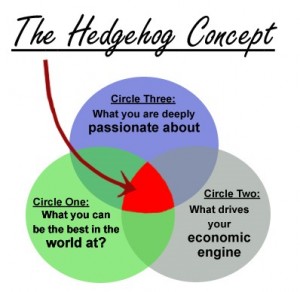In April 2013 I wrote a blog post called What Got You Here Won’t Get You There: Lessons for New Leaders. That post is worth taking a look at if you’re interested in really developing your practice but I’m mentioning it because in it I refer to a book written by Seth Godin called The Dip that contains a message that is the subject of this post.
The Dip is a tiny book that can be read in an afternoon! But it contains an incredibly big message for the rapidly changing business world in which we now live. Godin starts off with a Vince Lombardi quote “quitters never win and winners never quit.” Godin says “Bad advice. Winners quit all the time. They just quit the right stuff at the right time.”
The book then gives you guidance on when to quit and when to persevere. That’s why I think you should read it.
The essence of a practice development journey (in fact any life journey) is change. At least I assume that to be the case. It doesn’t make much sense doing this if you are totally happy with your business model and the results you’re getting.
So with that as my starting point I’m going to suggest that as you head off on this journey you’re going to see the road fork at various places. In keeping with Robert Frost’s advice I suggest that you take the road less traveled because that will make all the difference. To do otherwise is to follow the rest of the pack and you’ll end up at the same place as them – in the sea of sameness I call it.
I shall be telling this with a sigh
Somewhere ages and ages hence:
Two roads diverged in a wood, and I—
I took the one less traveled by,
And that has made all the difference.
Robert Frost
 When you take the road less traveled it is certain that the journey will be fun for a while. You’ll feel you’re making progress but the further you get from familiar surroundings and start to confront challenges you may not have seen before your initial enthusiasm will start to wane. This is the “Dip”
When you take the road less traveled it is certain that the journey will be fun for a while. You’ll feel you’re making progress but the further you get from familiar surroundings and start to confront challenges you may not have seen before your initial enthusiasm will start to wane. This is the “Dip”
The Dip is where it’s not too much fun anymore. The going gets hard, the uncertainty of the outcome seems to increase and we start to ask ourselves questions like “is it worth it”, “can I do it”, “what’s wrong with what I’ve got”, “what if it doesn’t work” etc. etc.
BUT here’s Godin’s big message.
We’ve all experienced a Dip at various times in our lives from the time we started to walk, to the time we went to college, to when we started golf or skiing or anything else that required the acquisition of skill through experience and learning.
And we have all got through the dips we’ve faced and persevered with in the past. And if something’s worth doing it’s inevitable it will present you with a Dip. And it’s the place where your sense of success happens as you break through the barriers. And the deeper the Dip the greater the reward. And the deeper the Dip – this is the KEY POINT – the less likely it will be that your competitors will follow you because most people, once they get settled in their life do not pursue greatness. As Godin says “they settle for less than they are capable of” which is what I was blogging about back in April.
Winners know that most people will not be able to make it through the Dip to the other side so they end up coming out on top and that’s the only place to be. That’s the payoff from having a sustainable competitive advantage. Please read or re-read Porter’s HBR article, What is Strategy?
The pursuit of excellence is what this is all about – this book and this program. I want you to get in your head that your firm can be the best in the (“your”) world. There is absolutely no reason why that can’t happen.
Jim Collins in Good To Great talks about this in Chapter 5: The Hedgehog Concept. This is another resource that I strongly recommend you read or listen to it’s also available on audible.com. It will give you a powerful armory of ideas to share with your clients when you’re helping them build a great business.
 The hedgehog concept refers to three intersecting circles where the sweet spot of excellence sits at the point of intersection. Based on the extensive research Collins and his team did on what makes good firms great they found that three characteristics where consistently in play in the great firms. They are:
The hedgehog concept refers to three intersecting circles where the sweet spot of excellence sits at the point of intersection. Based on the extensive research Collins and his team did on what makes good firms great they found that three characteristics where consistently in play in the great firms. They are:
When you think about Collins’ idea in the context of the Dip it’s easy to see the relationship between the pursuit of excellence and being passionate about what you do – you’ll never get out of the Dip if you’re not passionate about your reason for being there in the first place i.e. your purpose, your WHY in Simon Sinek’s language – see his book Start With Why or take 18 minutes to check out his TED presentation.
You won’t find yourself in a Dip unless you are pursuing excellence i.e. to be the best in your world you’re going to face some challenges. And then, of course, it must make economic sense.
Godin suggests there are only three curves in business and life—well two curves and one cul-de-sac actually.
The first curve is the Dip. The other is the Cliff. That’s the one that is clearly a bad trajectory that may be up for a while but then comes crashing down. Bad habits moral, physical or social fit this curve.
The cul-de-sac is the interesting place because that’s where average is found. It could also be called the sea of sameness. It’s the comfortable, predictable place. There’s nothing wrong being in the cul-de-sac if that’s where you want to be but there’s everything wrong being there in the hope that something is going to change that will get you out because that’s not going to happen.
Godin talks about three types of people. The first group he calls the brave. These are the ones who know where they want to go, get in the DIP, tough it out, get through and reap the rewards.
Then there are the mature ones. They make the sensible decision of not starting the quest because they don’t believe they can get through or they really don’t want to. He puts Jack Welch in this category at least in relation to his strategic position that GE would be #1 or #2 in every industry it was in or it was out of there by sale, dissolution or repair. In other words there were some Dips Jack did not want to endure. Rather he wanted to deploy his resources where he could get through the Dip. So choosing not to proceed is not a weak decision. It is a super smart one.
Then finally there are those people who make a stupid decision. They put time, effort and money into a project then quit right in the middle of the Dip—this is the lowest, toughest part of the journey. Sadly, in Collins (and my) experience this is the all-too-common choice. It’s the one that leads to motivational chants such as “it’s darkest (coldest) just before dawn!”
However, the people who keep their focus and break through the Dip are the ones who own the new space. They reap the rewards. They get there by perseverance but no less importantly by pivoting at the right places after learning from their errors of judgment or execution. And that’s where the business model generation process comes into play. In his 2008 book Tribes Godin says (p 108):
The secret of being wrong isn’t to avoid being wrong. The secret is being willing to be wrong. The secret is realizing that being wrong isn’t fatal. The only thing that makes people and organizations great is their willingness to not be great along the way. The desire to fail on the way to reaching a bigger goal is the untold secret of success.
Getting through the Dip is really all about tweaking the success drivers. For example, I’ll hear two people say “my clients aren’t interested in this stuff.”
- One of those people will then say “so I’m going to go back to what I know I can get paid for.” In other words, back into the cul-de-sac.
- But the other one of them will say “so therefore I’m going to focus on getting a different group of clients” or “I’m going the experiment with different ways of presenting this value proposition” or “I’m going to re-package this service so it fits better with their budget.” And he’ll keep pivoting until he finds the sweet spot and then his history will be written.
Sustainable competitive advantage comes from being in the Dip. The way to break through is to adopt what I like to call the Plan, Play, Evaluate, Pivot, Plan process. Which goes like this for every element of your business.
Plan what you’re going to do with a clear destination in mind and intermediate benchmarks in place.
Implement the Play and Monitor the outcome against the benchmark.
If the outcome falls short of the benchmark Pivot by re-visiting the Plan or re-visiting the Play.
